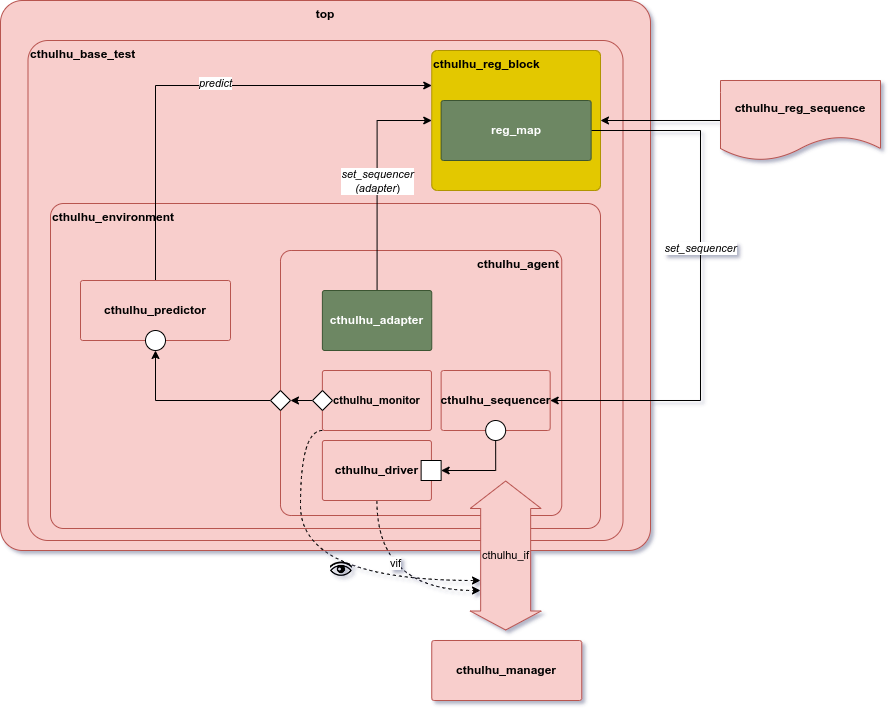The Adapter
Hands-on to implement a simple UVM ambient with RAL
The Adapter
Overview
Okay, now we have the registers modeled using the uvm_reg and uvm_reg_block. However, our UVM ambient uses transactions to communicate between components. The UVM ports transport transactions, and the register models are not transactions. So, we need a way to easily convert the registers to transactions and vice versa, and this is the main function of an adapter.
Writting an adapter
Basically, an adapter will have two functions:
uvm_sequence_item reg2bus(const ref uvm_reg_bus_op rw)void bus2reg(uvm_sequence_item bus_item, ref uvm_reg_bus_op rw)
Just to remember, the
refmeans that the value is passed by reference, and not by copy
reg2bus
The reg2bus will convert a RAL transaction to an Interface transaction. It receives as argument an uvm_reg_bus_op. This is a struct with the following fields:
kind (read or write)
address (Bus address)
data (Data to write)
n_bits (Number of bits of
uvm_reg_item::valuetransferred by this transaction)byte_en (Enables for the byte lanes on the bus). I will confess that I didn't undestand this, but we won't use in this Hands'on
status (Result of transaction:
UVM_IS_OK,UVM_HAS_X,UVM_NOT_OK)
So, let's code this function:
function uvm_sequence_item reg2bus(const ref uvm_reg_bus_op rw);
cthulhu_transaction tx;
tx = cthulhu_transaction::type_id::create("tx");
tx.write_en = (rw.kind == UVM_WRITE);
tx.addr = rw.addr;
if (tx.write_en) tx.data_w = rw.data;
if (!tx.write_en) tx.data_r = rw.data;
return tx;
endfunction : reg2busWhen a register is read/written, the
uvm_reg_mapcalls theuvm_sequence_base::start_item(), passing the object returned byreg2bus()function.
bus2reg
It's the opposite idea of the reg2bus(). This function will convert a Interface transaction into a RAL transaction. Let's code:
function void bus2reg(uvm_sequence_item bus_item, ref uvm_reg_bus_op rw);
cthulhu_transaction tx;
assert( $cast(tx, bus_item) )
else `uvm_fatal("", "A bad thing has just happened in my_adapter")
rw.kind = tx.write_en ? UVM_WRITE : UVM_READ;
rw.addr = tx.addr;
rw.data = tx.data_r;
rw.status = UVM_IS_OK;
endfunction : bus2regSo, the rest of class is similar to every component of UVM. The complete code is shown below:
class cthulhu_adapter extends uvm_reg_adapter;
`uvm_object_utils (cthulhu_adapter)
function new(string name = "cthulhu_adapter");
super.new(name);
endfunction
function uvm_sequence_item reg2bus(const ref uvm_reg_bus_op rw);
cthulhu_transaction tx;
tx = cthulhu_transaction::type_id::create("tx");
tx.write_en = (rw.kind == UVM_WRITE);
tx.addr = rw.addr;
if (tx.write_en) tx.data_w = rw.data;
if (!tx.write_en) tx.data_r = rw.data;
return tx;
endfunction : reg2bus
function void bus2reg(uvm_sequence_item bus_item, ref uvm_reg_bus_op rw);
cthulhu_transaction tx;
assert( $cast(tx, bus_item) )
else `uvm_fatal("", "A bad thing has just happened in my_adapter")
rw.kind = tx.write_en ? UVM_WRITE : UVM_READ;
rw.addr = tx.addr;
rw.data = tx.data_r;
rw.status = UVM_IS_OK;
endfunction : bus2reg
endclass : cthulhu_adapterOkay, now our ambient is a little morre colorful:
